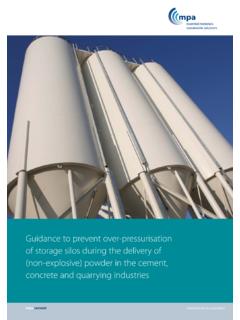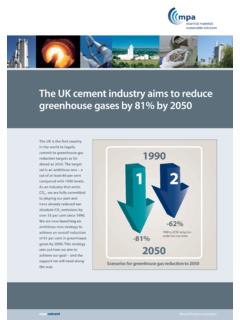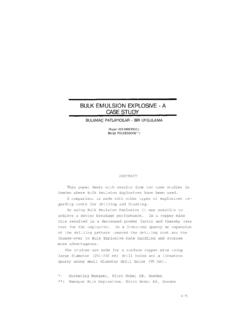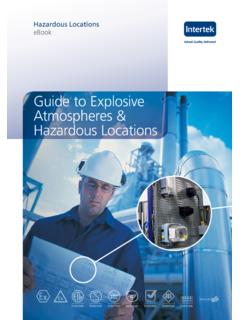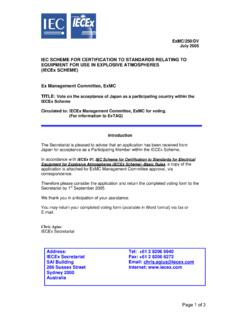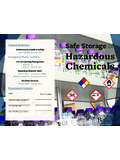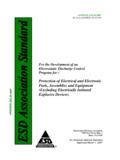Transcription of concrete and quarrying industries
1 Mpacementmineral products associationGuidance to prevent over-pressurisationof storage silos during the delivery of(non-explosive) powder in the cement, concrete and quarrying industriesmpacementThis document addresses the problems of over-pressurisation of storagesilos during the pneumatic delivery of powder (See Appendix E SiloIncidents). It is a cement/quarry industry update of an earlier version whichhad been produced in conjunction with the Health and SafetyExecutive/Laboratory in order to identify the best industry practice for theoperation of silos in order to prevent such information contained in this document is designed to identify the keyissues associated with delivery, provide guidance on preventing over-pressurisation and improve the over-all operation of following recommendations are made: Ensure adequately sized PRVs are fitted to silos and that they are maintained and operated correctly, so as to mitigate any over-pressurisation.
2 Automatic shut-off systems are used to prevent over-pressurisation from occurring. These should be used with all new installations and, where reasonably practicable, existing installations should be modified; Operate in accordance with the guidelines detailed in this document, which outlines the best industry information contained within this Guidance is given in good faith and belief in its accuracy at time of its publication, but doesnot imply any legal liability or responsibility to the contributing of this guidance must pay regard to any relevant legislation or authorative recommendations which may have evolvedsubsequent to the date of public sector information licensed under the Open Government Licence Summary1mpacementContents2 IntroductionDescription of Road tankers Air-discharge Interconnecting hoses and feed lines Receiving Filter systems Warning systems Pressure relief valve (PRV ) Discharge ProcessMaintenance of equipmentRisk assessmentsRisk control Silos Filters Maximum rate of material transfer Tanker venting Pressure Relief Valves (PRVs)
3 Automatic Shut-off systems Operating procedures Duties Recommendations ReferencesAcknowledgmentsAppendix AInformation requirements Appendix BExample calculation Appendix CHazard checklist Appendix DDriver training Appendix ESilo incidents12345678910 3444455567899910101010111213141414151820 2425 Page mpacement1all pressures are given as gauge pressures ( pressure above atmospheric) and not absolute pressureIntroduction3 The cement/ quarrying industry handles many millions of tonnes of powder every year. It is commonpractice for these powders to be transported by road in tankers. The loads are discharged by fluidising thepowders and blowing them into a silo (pneumatic conveying).
4 The air used to carry the powder is ventedfrom the top of the silo through filters. If the air entering the silo is not vented adequately, delivery in thismanner may result in over-pressurisation and consequent rupture of the silo, ejection of the filter systems orsilo lid. Suitable pressure relief devices should be fitted to all powder above (1 ) may be sufficient to damage silos. Although the discharge pressure at theoutlet of the delivery pipe at the top of the silo will be of this magnitude, the pressure at the tanker end willbe very much greater and will vary depending on the silo height, length of pipe, number of bends, powderdensity can occur due to one or more of the following: Increase in flow rate of air from the tanker at end of discharge; Overfilling of silo; Failure of Pressure Relief Valve to vent flow rate from tanker; Inadequate flow through the filters; Inadequate maintenance or design of the above equipment.
5 And Uncontrolled discharge of residual air from the rise in air flow to the silo occurs when the density of the fluidised powder is reduced, especially at the endof delivery. This transition stage is short, but could result in a catastrophic pressure rise in the silo. Themaximum instantaneous flow rate of air may be as high as (~6900 cfm) (see Appendix A).This document applies to all silo installations which are used for non-flammable powders (for which thereare no explosion risks) in the cement and related industries . The aims are to: Prevent silo over-pressurisation and if this is not reasonably practicable, mitigate the effects; Advise on the equipment used in the delivery process and any short comings in their operation; Identify the potential hazards associated with the delivery of cementitious material to silos; Provide guidance on assessing the risk associated with the delivery process; Provide guidance on the choice, assessment and fitting of protective devices; and Provide guidelines for designing new installations and improving existing requirements include Health and Safety at Work etc.
6 Act, the Management of Health and Safety atWork regulations, the Pressure Systems Safety Regulations, the Provision and Use of Work EquipmentRegulations and the Environmental Protection Act. Guidance on these can be found in the publicationslisted in the Section 9 and from the appropriate enforcing of tankers4 Road tankersBoth tipping and non-tipping, (belly) tankers can be pressurised and operate in a similar way to deliverpowders. The tankers have a blowing system, which provides air to transport powder into the silo. Tankerscurrently operate at up to 200 kPa (29 , 2 bar). A modern tanker, designed exclusively for use in theindustry, typically has a volume in excess of 40m3when operating at 44 Air-dischargeA compressor (blower) mounted on the tanker lorry (or mounted on the tank along with an auxiliaryengine) provides a supply of air.
7 This air: Pressurises the tanker vessel. The tank is pressurised at the start of the blow and maintained at operating pressure during the course of discharging; Fluidises the powder around the distributor plate; and Transports fluidised powder from the tanker, along the connecting pipework to the hoses and feed linesThe feed line which takes the powder from ground level to the top of the silo is a 100 mm (4") rigid tanker is usually connected to the feed line viaa flexible hose using a cone type coupling. The hose istypically rated to a pressure of ~ 500 kPa ( , 5 bar) and the couplings to > 800 kPa (116 , 8 bar)providing the coupling is sound and a good connection is are alternative fittings, which incorporate a positive locking action.
8 These couplings are rated to 1000kPa (145 , 10 bar) and above, depending on the material from which the coupling is made. The fittingsand blanking caps are also available with protective locking mechanisms and pressure-activated lockingdevices which ensure that connections cannot be broken if there is residual pressure in the 1 Cement tankers2mpacementReceiving 2 Filter housing on top of a silo installation3 Silos can be of varying styles, sizes and shapes; some are divided into a number of compartments. Theheight of a silo and the length of interconnecting pipework affect the rate at which powder may bedelivered from a road tanker. The higher the silo and the longer the pipework, the further the powder has tobe conveyed.
9 This alters the ratio of air to powder required to maintain the powder entering the silo from the feed line, the velocity of air/material decreases rapidly allowing the powder tofall from suspension. The powder is deposited in the silo whilst the air is vented from the silo, through filters,to systemsNot all of the powder transported into the silo settles out of suspension rapidly. Therefore the air leaving thetop of the silo needs to be filtered to prevent emissions of powder to the environment. This is achievedusing: Filter bag systems- these filter the air through a cloth bag, which removes particulate matter; Filter cartridge systems- these contain a series of cylindrical cartridges of pleated filter material.
10 The pleats in the material greatly increase the surface area of the cleaning systems are essential for reliable operation and to maintain filter efficiency. In general, this isachieved either by: Reverse jet cleaning- short blasts of air are fired against the normal direction of flow through the filter. These blasts last for a fraction of a second and dislodge any powders that are deposited in the filter material. This procedure is repeated at frequent intervals during the filling process to prevent the build up of deposits; Mechanical Shaking- filter bags are mechanically shaken for a predetermined length of time ( 30 secs- 5 mins) depending on the powders involved.
